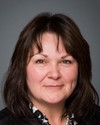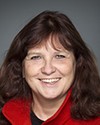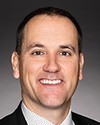Madam Chair, members of the committee, thank you.
My name is Linda Savoie, and I am the Director General of the Women's Program and Regional Operations. I am joined by Pascale Robichaud, Director of Strategic Partnerships and Operations, and Victoria Martino, Senior Program and Policy Analyst.
As you just mentioned, we have provided a handout. It will help keep me on track and hopefully stick to the timing appropriately.
The first chart, on page 2, illustrates the part of Status of Women that we belong to, the part that we will be speaking to today. Next week some of my colleagues will be appearing before you, and they will speak to the other aspects of Status of Women—in particular, policy, commemorative events, International Day of the Girl, and a number of other matters that I'm sure will be of interest to you.
Today, however, we will be focusing on the women's program. I will be starting from a fairly broad perspective about the program, and then I will gradually move toward what is of interest to you today: the issues that relate specifically to girls and their economic perspectives.
The women's program is a grants and contributions program. We have a mandate to advance equality for women in Canada. We are one of the very few programs at any level of government with that mandate.
Our mandate, while focusing on gender equality, is quite well aligned with various other federal priorities or initiatives. Whether we're talking about economic prosperity or family violence, there's quite an alignment between our mandate and the mandates of other departments and agencies within the federal family dealing with those issues.
We have a budget of approximately $19 million per year. With that grants and contributions budget, we fund some 300 projects every year. Approximately 80, sometimes up to 100, of these projects each year are new. The balance are projects that are continuing for a period of more than one year.
Our program is delivered through offices that are located in Edmonton, Montreal, Moncton, and Ottawa. The Ottawa office, under the responsibility of Madame Robichaud, also has the specific responsibility for national projects and for aboriginal projects. We will be touching on some of these as I advance in the briefing.
Page 4 outlines the role of the women's program. Our primary function, of course, is to fund community-based projects across Canada. In addition to that, we also participate in and bring our expertise to various interdepartmental working groups. We are actively involved in human trafficking working groups within the federal family, working groups that deal with seniors, with family violence, as I've mentioned before, and we try to bring the issues that affect women to the forefront in this work.
On a provincial-territorial level, we share information actively with our colleagues at the provincial level. We share about projects, we share about funding priorities, and we seek out opportunities to at times partner on projects or co-fund certain projects. This happens in a number of fields.
For instance, when we're funding projects that deal with employment of women in non-traditional trades, often the province will be funding the actual cost of training the participants, while we will be working with the employer aspect and the institutional barriers that are detrimental to women's recruitment or retention in that trade. So there's good complementarity between our work and what the provinces are doing, and a fair bit of alignment in terms of priorities.
Our projects can be up to 36 months in duration. We work with three pillars. Our three pillars are ending violence against women and girls, improving women and girls' economic security and prosperity, and increasing women and girls' leadership and democratic participation.
These priorities basically reflect the inequalities that continue to exist in Canada and in many parts of the world today, whether you're talking about the persistent issue of spousal or sexual violence, the gap in wage parity, or the underrepresentation of women in political and business positions. Those pillars are in fact consistent with the way most jurisdictions organize their strategies in tackling inequality.
In terms of what we fund, at times we focus on specific populations, whether we're focusing on girls, aboriginal women, or immigrant women. We have a multi-faceted approach. At other times, we focus on issues, for instance, a gap in services for women who are moving out of shelters and need second-stage housing. At other times, it's the issues, as I was mentioning before, of moving women into non-traditional employment.
We also have different approaches in terms of who we work with. We work with communities. We work with employers. We work with a broad range of organizations. What we are trying to do there, for the most part, is remove barriers that women face in participating in the economic, social, and democratic life in Canada.
This being said, at any given time approximately half of our projects are focusing on the issue of violence against women and girls.
If you'll bear with me for a few more slides on generalities about the program, then I will move into some more specifics with respect to girls.
How do groups apply to obtain funding? Organizations apply for funding to our program through two different routes, which we feel gives a fair bit of flexibility. The first is that they can respond to a targeted call for proposal. That's where we issue out a call and state specifically what we want applications to be addressing in terms of issues, or in terms of models we want to see tested, or in terms of populations that we want to see benefit from the project.
For instance, you may be familiar with the rural call that we launched last fall, in September. We were seeking projects that developed community plans to address either the issue of economic security or the issue of violence against women. That's the volet of targeted calls that we use to attract people to our program.
The other way of obtaining funding is simply for a group to identify an issue that they feel they can tackle and develop a proposal and apply it. At any time during the year, bring it to our attention and come up with a good, solid project that's aligned with our pillars.
In terms of the benefits to having this dual approach, we've found that it's allowed us to be responsive and also to be directive. We can do both things by having both the targeted calls and the continuous intake mechanisms. It allows us to invest more strategically than by simply sitting back and waiting to see what the groups are going to come up with. It potentially increases the reach of certain recipes that have shown success in some parts of the country so we can try to get them implemented across the country. We see this as a happy medium that allows us to build positive results from a number of angles.
Who can apply? We have a fairly broad potential market. Incorporated, Canadian, not-for-profit, as well as for-profit organizations can apply. It is an extremely diverse population of groups that apply for funding and that we in fact fund. We have small, local grassroots organizations. We have large national organizations, regional organizations.
Some of these are population-focused. For instance, there are groups that deal primarily with girls. Others are groups that are issue-based, for instance, groups that try to increase the participation of women in politics. Others are service providers. Others offer safe spaces, for instance, the shelters. But statistically, close to half our groups are women's groups in our ongoing analysis of who we're funding in the last four, five, or six years, nearly.
Our reach has been increasing in terms of how many groups are actually receiving funding from us for the first time. At our last assessment, approximately 40% of the groups receiving funding from the women's program were first-time recipients.
Now I'll move to an area of more specific interest to you: what we do with respect to girls. Girls have been and continue to be an important focus for the women's program. In approximately the last two years we have funded some 35 girl-specific projects. In addition to that, we have a number of projects that tackle the issue more broadly so that women and girls are benefiting.
Our approach has been rather holistic. The streams of violence, leadership, and economic security and prosperity tend to overlap and complement one another. This really is an acknowledgment of the complexity of the issues faced by women and girls and the interrelation between them, whether we're talking about the relationship between poverty and violence, role models and economic choices, etc. In our experience we rarely have projects that focus uniquely on one of those pillars.
This is also very much a reflection of the fact that the determinants of a girl's economic situation tend to be outside of her control in early life. Her economic situation will primarily be a function of her surroundings, her parental/family situation, etc. That's why our projects tend to focus on giving the girls skills, creating resilience, and creating conditions for their future success.
Our work varies tremendously in terms of either the approach we take or the population we choose to work with on a project-by-project basis.
For more specifics on some concrete girls' projects, I will defer to my colleagues here. They have much more intimate knowledge of some of the projects we thought we'd present to you as illustrations of our approaches.
Madame Martino will talk to you about the blueprint project theme that had a very girl-focused component last year. Then Madame Robichaud will speak to some aboriginal girls' projects.
Victoria.









